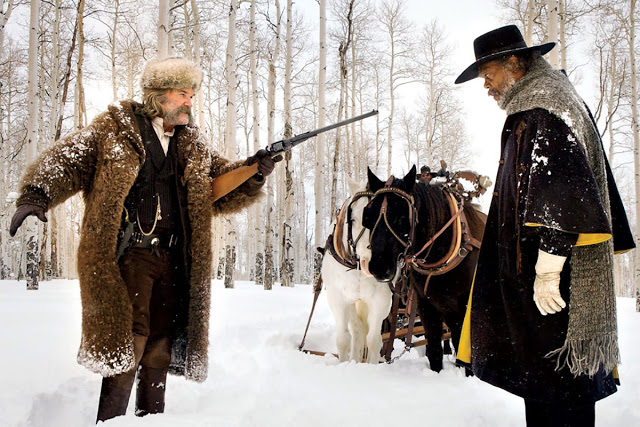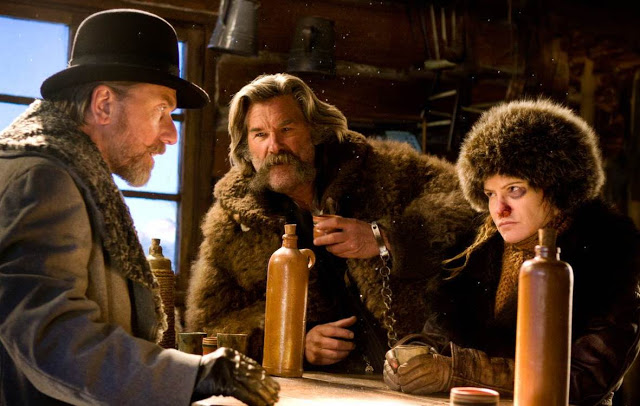The Hateful Eight is silly, self-indulgent, overlong, and obscenely ostentatious. It is also funny, bracing, suspenseful, and supremely entertaining. It is, in other words, a film by Quentin Tarantino, cinema’s poet laureate of grisly violence and savory dialogue. This is the kind of happily ridiculous movie where the no-good woman spends the entire second half with her face covered in blood, and where the manly men seem to have engaged in a mustache-growing contest. As a writerly work of fiction, The Hateful Eight is difficult to take seriously. As a thrilling piece of pulp art, it is impossible to dismiss.
That is especially true for cinephiles. The world’s most celebrated former video-store clerk, Tarantino can be exasperating in his nerdy superiority, his compulsion to constantly remind you of the scope of his encyclopedic knowledge of film’s annals. But he possesses real love for the movies, and The Hateful Eight—which, as the opening title card gratuitously announces, is the eighth picture of his career—is his most pronounced valentine to the form yet. Shot in the fossilized format of 65-millimeter film, its languorous opening scenes—featuring painterly images of a stagecoach striving against the snow of a Wyoming blizzard (shooting took place in Colorado), and of a cloaked man with his head bowed against the cold—beautifully capture the visual majesty of the medium. (Most theaters with digital projectors are showing The Hateful Eight in a slightly truncated version, but a “traveling roadshow” is exhibiting the film in select areas in 70mm, complete with an overture, intermission, and a few extended scenes.) Tarantino’s screenplays may go overboard with their insouciant humor, but in these striking early scenes (shot by Oscar-winning cinematographer Robert Richardson), he makes clear that his craft is not a joke. To him, movies still matter.
Whether the particular story told in The Hateful Eight matters is less certain. Oftentimes, it feels like a glorified excuse to dump a bevy of talented character actors in a room together and let them gargle Tarantino’s stylized dialogue. Indeed, apart from the film’s opening act (the movie is cleanly divided into six distinct chapters, standard operating procedure for Tarantino), it takes place almost entirely indoors. This relative confinement makes The Hateful Eight a curious choice to serve as the standard-bearer for a 70mm revival, as it minimizes the opportunities for aesthetic opulence; although Tarantino’s blocking of the characters is adroit, there are only so many creative ways you can shoot an octet of people huddled within four walls.
But back to that blizzard-beset stagecoach for a moment. Its two occupants are John Ruth (Kurt Russell, sporting the grandest mustache of them all) and Daisy Domergue (Jennifer Jason Leigh, having a blast), and while they occasionally laugh and bicker like an old married couple, their relationship is far from harmonious—a point made hideously clear when John, displeased with one of Daisy’s japes, sharply elbows her in the face. Daisy, we learn, is a murderess, and John is an infamous bounty hunter nicknamed “The Hangman”; he is transporting his captive to the village of Red Rock for execution. On the snowy road, they collect another bounty hunter, Major Marquis Warren (Samuel L. Jackson, giving his most committed performance in years), along with Chris Mannix, a southerner who proclaims himself to be Red Rock’s sheriff but who is instantly untrustworthy by virtue of being played by Justified‘s Walton Goggins. Eventually, the snowstorm requires them to hole up at a shop-cum-saloon dubbed Minnie’s Haberdashery. There, they encounter a curious group of colorful characters: Oswaldo Mobray, an eloquent hangman (Tim Roth); Joe Gage, a laconic cowpuncher (Michael Madsen); Sandy Smithers, a former general in the Confederacy (Bruce Dern); and Bob, the ranch hand who runs the place in Minnie’s absence (Demian Bichir). Given the movie’s title, you presumably need not tick off each of these names on your fingers to arrive at their sum total. (Technically, I count nine, but apparently no one cares about the stagecoach driver, played by Tarantino regular James Parks.)
That makes for one crowded haberdashery, and it’s hardly a spoiler to divulge that, over the remainder of The Hateful Eight‘s exorbitant runtime, tempers will flare, aspersions will be cast, and, eventually, firearms will be discharged. This all happens gradually, or perhaps glacially. “Let’s slow it way down,” Marquis decrees at one point, and as much evident glee as Tarantino takes in making movies, he is certainly in no hurry. He prefers to allow his characters to slowly circle one another, and to let them each ramble on in his flavorful dialogue, so that even a casual greeting becomes an intricate dance of wordplay.
This is both a blessing and a curse. Tarantino is a gifted wordsmith, and much of his writing sings with rhythm and wit. “You got me at a disadvantage,” Mannix says to John Ruth, to which the latter responds, “Keeping you at a disadvantage is an advantage I intend to keep.” Such circumlocutions can be manna from heaven for voracious actors, a chance to revel in the artificial pleasures of showy speeches and orotund diction. The obvious highlight here is a drawling monologue from Jackson—an extended taunt that is at once playful and outrageously profane—but the performers who best fit Tarantino’s heightened style are Roth (filling in for Christoph Waltz in the role of European highbrow) and Goggins (demonstrating the same knack for delivering lurid dialogue as he showed on Justified), both of whom accent their line readings with just the right level of mischievousness. At the same time, Tarantino’s penchants—for endless repetition, for feigned politeness, for taking forever to get to the damn point—can often make the picture feel interminable. Occasionally, you just want the characters to shut up and start killing each other already.
Thankfully, at its halfway point, The Hateful Eight nimbly morphs from a hyperbolic Western into a delicious mystery worthy of Agatha Christie. Tarantino has always been adept at wringing tension from a scene, but here he borrows brilliantly from Hitchcock—as the aphorism goes, a poisoned coffeepot is never more ominous than when the audience knows it’s been poisoned—lending the film a frisson of mind-teasing excitement. It doesn’t last, of course; Tarantino is more of a showman than a schemer, and as The Hateful Eight builds to its gonzo conclusion, it becomes increasingly preposterous and excessive. Tarantino ultimately gives the movie over to Leigh, who gnashes at the scenery with rotted prosthetic teeth, revitalized by the opportunity to go crazy for once.
Going crazy is basically The Hateful Eight‘s raison d’être, but there is still ample craft and thoughtfulness animating its absurdist theater. It’s a hypnotic, freewheeling mess that never stops being enjoyable, even when it grows too outlandish for its own good. In one scene, in an attempt to defuse a heated, racially charged argument, Oswaldo quips, “I know Americans aren’t apt to let a little thing like unconditional surrender get in the way of a good war.” Touché. And in harnessing his considerable powers, Tarantino is not inclined to let traditional filmmaking virtues—discipline, propriety, credibility—get in the way of making a good movie.
Jeremy Beck is the editor-in-chief of MovieManifesto. He watches more movies and television than he probably should.



